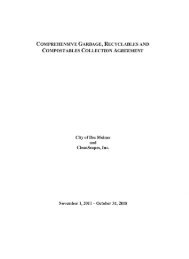CITY OF DES MOINES SHORELINE MASTER PROGRAM
CITY OF DES MOINES SHORELINE MASTER PROGRAM
CITY OF DES MOINES SHORELINE MASTER PROGRAM
Create successful ePaper yourself
Turn your PDF publications into a flip-book with our unique Google optimized e-Paper software.
Des Moines Shoreline Master Program<br />
If any part of a proposed development is not eligible for exemption, then a substantial<br />
development permit is required for the entire proposed development project, per WAC 173-27-<br />
040(d). Local government may attach conditions to the approval of exempted developments<br />
and/or uses as necessary to assure consistency of the project with the SMA and Des Moines<br />
SMP, per WAC 173-27-040(e).<br />
The following shall not require Substantial Development Permits:<br />
1. Any development of which the total cost or fair market value, whichever is higher, does not<br />
exceed five thousand seven-hundred and eighteen dollars ($5,718), if such development does<br />
not materially interfere with the normal public use of the water or shorelines of the state and<br />
does not result in a net loss of ecological functions. For purposes of determining whether or<br />
not a permit is required, the total cost or fair market value shall be based on the value of<br />
development that is occurring on shorelines of the state as defined in RCW 90.58.030 (2)(c).<br />
The total cost or fair market value of the development shall include the fair market value of<br />
any donated, contributed or found labor, equipment or materials.<br />
2. Normal maintenance or repair of existing structures or developments, including damage by<br />
accident, fire or elements. “Normal maintenance” includes those usual acts to prevent a<br />
decline, lapse, or cessation from a lawfully established condition. "Normal repair" means to<br />
restore a development to a state comparable to its original condition, including, but not<br />
limited to its size, shape, configuration, location and external appearance, except where<br />
repair involves total replacement which is not common practice or causes substantial adverse<br />
effects to the shoreline resource or environment. Normal repair must occur within a<br />
reasonable period after decay or partial destruction. If decay or partial destruction occurs to<br />
an extent of fifty percent (50%) or greater of the replacement cost of the original<br />
development, repair or replacement must be addressed within one year<br />
Reconstruction conditions for nonconforming structures, including single-family residences,<br />
destroyed by catastrophe or disaster such as fire, explosion, earthquake, flooding, etc., may<br />
be reconstructed as existed prior to the catastrophic event, excluding reconstruction<br />
necessitated by a criminal act involving the property owner, with building height and<br />
shoreline setbacks not to exceed pre-existing setbacks and restrictions. Furthermore, when<br />
any new building is proposed in addition to reconstruction, the new building area shall<br />
conform to the provisions of this Program and conform to the requirements of Des Moines<br />
Municipal Building Code and this Program. Replacement may include total replacement of<br />
buildings and structures when supported by a statement from the Building Official that<br />
complete replacement is common practice and the replacement does not cause substantial<br />
adverse effects to shoreline resources or the environment.<br />
3. Construction of a normal protective bulkhead common to single family residences. A<br />
“normal protective” bulkhead includes those structural and non-structural developments<br />
installed at or new, and parallel to the ordinary high water mark for the sole purpose of<br />
protecting an existing single family residence and appurtenant structures from loss or damage<br />
by erosion. A normal protective bulkhead is not exempt if constructed for the purpose of<br />
creating dry land. When a vertical or near vertical wall is being constructed or reconstructed,<br />
not more than one cubic yard of fill per one foot of wall may be used as backfill. When an<br />
existing bulkhead is being repaired by construction of a vertical wall fronting the existing<br />
wall, it shall be constructed no further waterward of the existing bulkhead than is necessary<br />
Department of Ecology approval effective November 1, 2010<br />
Adopted by City of Des Moines Ordinance No. 1502 89



